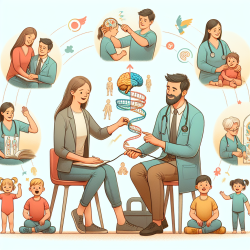Introduction
As a practitioner in the field of speech-language pathology, particularly when working with children, understanding the integration of mental health and disaster preparedness can be crucial. The research article titled "The Integration of Mental Health and Psychosocial Support and Disaster Risk Reduction: A Mapping and Review" provides valuable insights into how these fields can be intertwined to improve outcomes for children. This blog post will explore the key findings of this research and how they can be applied in practice to enhance child outcomes.
Understanding the Integration
The research highlights a growing trend towards integrating Mental Health and Psychosocial Support (MHPSS) with Disaster Risk Reduction (DRR). This integration is essential as it promotes resilience and preparedness, reducing the risks of adverse mental health outcomes during disasters. The study emphasizes the importance of building capacity, developing policies, and raising awareness to effectively integrate these fields.
Key Domains of Action
The study identifies several domains where MHPSS and DRR integration can be particularly effective:
- Capacity and Systems Building: Developing mental health systems and increasing the capacity for implementing interventions is crucial. Training manuals and projects that focus on building local capacity are highlighted as effective strategies.
- Preparedness: Emphasizing preparedness can significantly increase coping abilities and reduce distress during emergencies. The study suggests that MHPSS preparedness should be prioritized in healthcare approaches, especially in regions prone to frequent emergencies.
- Policy Development and Awareness Raising: The integration of MHPSS into DRR policies requires consensus among stakeholders. The study discusses challenges and opportunities for achieving this integration, highlighting the need for increased awareness and policy inclusion.
- School-Based and Child-Focused DRR: Initiatives that focus on children and schools are crucial for reducing risks and building resilience. Training programs and manuals that incorporate MHPSS components in school settings are recommended.
Practical Implications for Practitioners
For practitioners, understanding and applying the integration of MHPSS and DRR can lead to better outcomes for children. Here are some practical steps to consider:
- Incorporate disaster preparedness into therapy sessions, teaching children coping strategies and resilience-building techniques.
- Collaborate with schools to develop comprehensive preparedness plans that include MHPSS components.
- Advocate for policy changes that prioritize mental health in disaster preparedness and response strategies.
- Engage with local communities to raise awareness about the importance of integrating mental health into disaster risk reduction efforts.
Encouraging Further Research
While the study provides a solid foundation for integrating MHPSS and DRR, there is still much to learn. Practitioners are encouraged to engage in further research to explore innovative strategies and interventions that can enhance this integration. By doing so, we can continue to improve outcomes for children and build more resilient communities.
To read the original research paper, please follow this link: The Integration of Mental Health and Psychosocial Support and Disaster Risk Reduction: A Mapping and Review.










